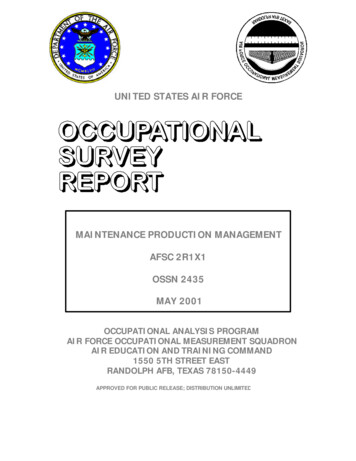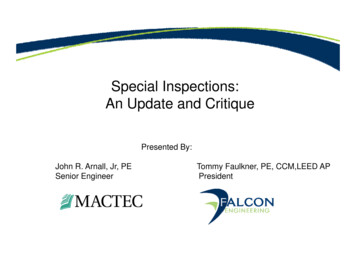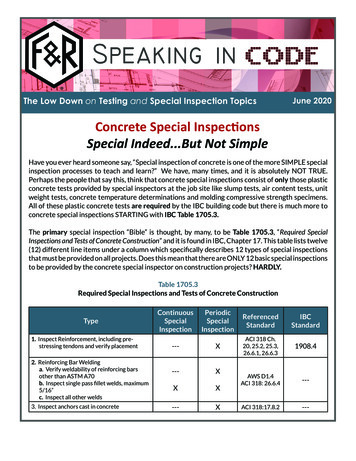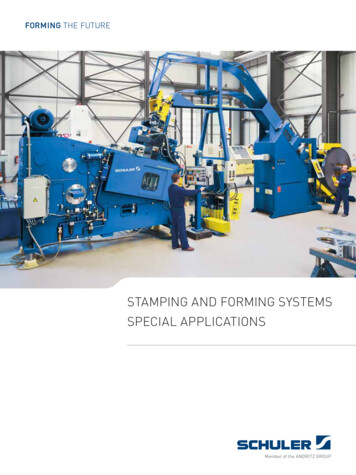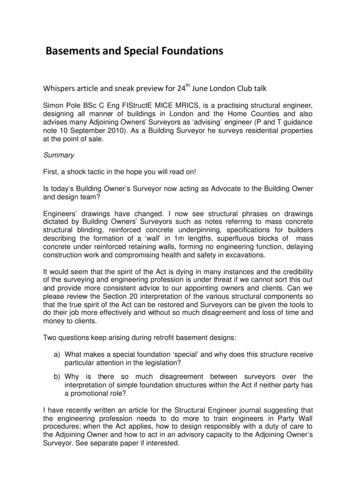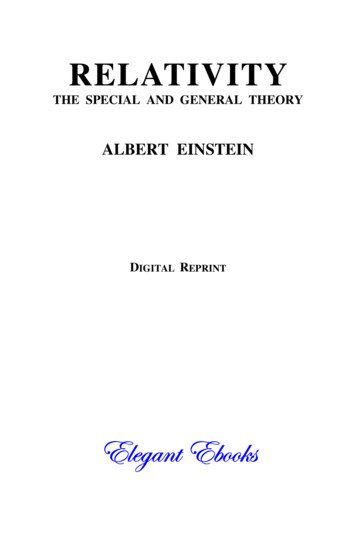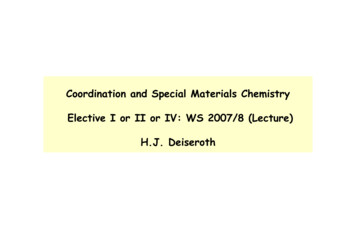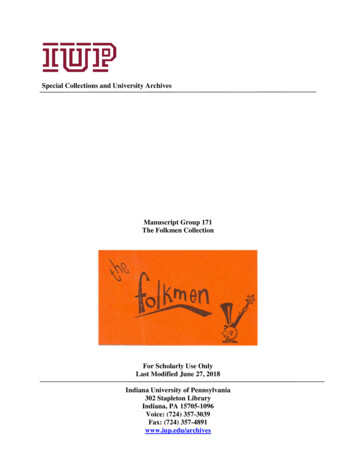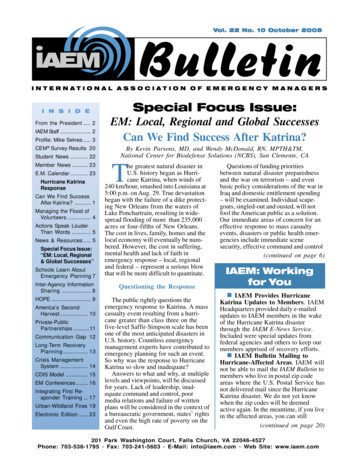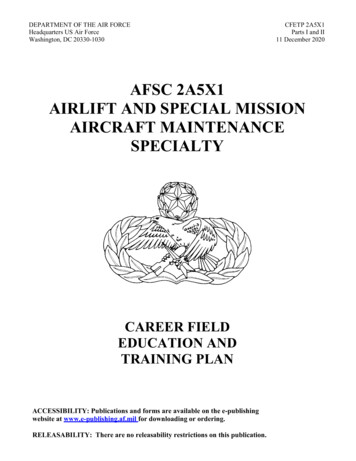
Transcription
DEPARTMENT OF THE AIR FORCEHeadquarters US Air ForceWashington, DC 20330-1030CFETP 2A5X1Parts I and II11 December 2020AFSC 2A5X1AIRLIFT AND SPECIAL MISSIONAIRCRAFT MAINTENANCESPECIALTYCAREER FIELDEDUCATION ANDTRAINING PLANACCESSIBILITY: Publications and forms are available on the e-publishingwebsite at www.e-publishing.af.mil for downloading or ordering.RELEASABILITY: There are no releasability restrictions on this publication.
SUMMARY OF CHANGES. As a result of the 22 July – 9 August 2019 Specialty TrainingRequirements Team Workshop, the Specialty Training Standards (STSs) contained in this Career FieldEducation and Training Plan (CFETP) have significant changes in Core Tasks, proficiency codes, andSTS line item numbers.i
CAREER FIELD EDUCATION AND TRAINING PLANAIRLIFT AND SPECIAL MISSION AIRCRAFT MAINTENANCESPECIALTY AFSC 2A5X1PART ITable of ContentsPagePreface . 1Abbreviations/Terms Explained . 2Section A--General Information . 3Purpose of the CFETPUse of the CFETPCoordination and Approval of the CFETPSection B--Career Progression and Information . 4Specialty DescriptionSkill and CareerProgression ApprenticeLevel (3)Journeyman Level (5)Craftsman Level (7)Superintendent Level(9) Training DecisionsCCAF/Higher Education and Advanced CertificationOpportunities Career Field PathBase/Unit Education and Training Manager ChecklistSection C--Skill-Level Training Requirements . 10PurposeSpecial QualificationRequirements ApprenticeLevel (3)Journeyman Level (5)Craftsman Level (7)Superintendent Level (9)Section D--Resource Constraints . 14Section E--Transitional Training Guide. 14ii
PART IISection A--Specialty Training Standard .15Section B--Course Objective List .16Section C--Support Materials.17Section D--Training Course Index .17Section E--MAJCOM Unique Requirements .20STS Attachments1. Proficiency Code Key .212. Aircraft Maintenance Common Training Requirements .233. 2A5X1A, C-40 Qualitative Requirements .334. 2A5X1A, E4/VC25 Qualitative Requirements .555. 2A5X1B, C-130 Qualitative Requirements .646. 2A5X1C, C-5 Qualitative Requirements .917. 2A5X1D, C-17 Qualitative Requirements .103Supersedes: This publication supersedes CFETP 2A5X1, 1 October 2016 and CFETP 2A5X1C1, 22May 2018.OPR: 362 TRS/TRRCertified By: Mr. Danny R. Taylor, GS-12 (362 TRS/TRR)Approved By: CMSgt Robert Rafferty (HQ USAF/A4LM)Number of Printed Pages: 119iii
AIRLIFT AND SPECIAL MISSION AIRCRAFT MAINTENANCESPECIALTY AFSC 2A5X1CAREER FIELD EDUCATION AND TRAINING PLANPART IPREFACE1. Career Field Education and Training Plan (CFETP). This CFETP is a comprehensive educationand training document that identifies life-cycle education and training requirements, training supportresources, and minimum Core Task requirements for 2A5X1, Airlift and Special Mission AircraftMaintenance Specialty. The CFETP will provide personnel a clear career path to success and instillsrigor in all aspects of career field training. This CFETP supersedes 2A5X1 CFETP published 1 October2016 and CFETP 2A5X1C1, 22 May 2018. Information is available at Air Force Publications website.NOTE: Civilians occupying associated positions will use Part II to support duty position qualificationtraining.2. CFETP Parts. The CFETP consists of two parts. Supervisors will use both parts to plan, manage,and control training. Using guidance provided in the CFETP will ensure individuals in this specialtyreceive effective and efficient training at the appropriate point in their career. This plan will enable us totrain today’s work force for tomorrow’s jobs.2.1. Part I provides information necessary for overall management of the specialty. Section A explainshow everyone will use the plan. Section B identifies career field progression information, duties andresponsibilities, training strategies, and career field path. Section C associates each level with specialtyqualifications (knowledge, education, experience, training, and other). Section D indicates resourceconstraints to accomplishing this plan, such as funds, manpower, equipment, and facilities. Section Eidentifies transition training guide requirements for SSgt through MSgt.2.2. Part II includes the following: Section A identifies the Specialty Training Standard (STS) andincludes duties, tasks, technical references to support training, Air Education and Training Command(AETC) conducted training, wartime course/Core Task, and correspondence course requirements.Section B contains the course objective list and training standards supervisors will use to determine ifAirmen have satisfied training requirements. Section C identifies available support materials, such asQualification Training Package (QTP), which may be developed to support proficiency training. SectionD identifies a training course index that supervisors can use to determine if resources are available tosupport training. Included here are both mandatory and optional courses. Section E identifies MAJCOMunique training requirements supervisors can use to determine additional training required for theassociated qualification needs. At unit level, supervisors and trainers will use Part II to identify, plan,and conduct training commensurate with the overall goals of this plan.1
ABBREVIATIONS/TERMS EXPLAINEDAdvanced Training. Formal course, which provides individuals who are qualified in their Air ForceSpecialty (AFS) with additional skills/knowledge to enhance their expertise in the career field. Trainingis for selected career Airmen at the advanced level of an AFS.Air Force Job Qualification Standard (AFJQS). A comprehensive task list that describes a particularjob type or duty position. Supervisors use the AFJQS to document task qualifications. The AFJQS tasksare common to all persons serving in the described duty position.Career Field Education and Training Plan. A CFETP is a comprehensive, multipurpose documentcovering the entire spectrum of education and training for a career field. It outlines a logical growth planthat includes training resources and is designed to make career field training identifiable, eliminateduplication, and ensure training is budget defensible.Continuation Training. This is additional training that exceeds minimum upgrade requirements and hasan emphasis on present or future duty assignments.Core Task. Tasks that the Air Force Career Field Manager (AFCFM) identifies as minimumqualification requirements within an AFS. Only a percentage of critical tasks for each system are listedas mandatory Core Tasks. This gives units needed flexibility to manage their workforce training.Electronic Training Record. A web-based application providing Air Force Warfighters with global,real-time visibility into the technical qualifications, certifications, and training status of logistics,communications and information professionals Air Force wide. Electronic training records support base,wing, and work center level training management activities by automating training management businessprocesses. The primary users of electronic training records will be any personnel directly involved inbase level training management and certification activities. Electronic training records were developedand maintained by 754th Electronic Systems Group, Installation and Logistics, Maintenance Flight (754ELSG/ILM) at Maxwell-Gunter AFB.Enlisted Specialty Training (EST). A mix of formal AETC training and OJT training designed toqualify and upgrade Airmen in each skill level of a specialty.Exportable Training. Additional training via computer assisted, paper text, interactive video, or othernecessary means to supplement training.Go/No Go Level. In OJT, the stage at which an individual has gained enough skill, knowledge, andexperience to either be qualified to perform an identified task without error or cannot perform the taskwithout error.Initial Skills Training. Initial skills training is the AFS specific training an individual receives uponentry into the Air Force or upon retraining into this specialty for award of the 3-skill level AFS Code(AFSC). This training is conducted at various locations by AETC.On-the-Job Training. Hands-on, over-the-shoulder training at the duty location used to certifypersonnel for both skill level upgrade and duty position qualification.2
Proficiency Training. Proficiency training is additional training, either in-residence or exportableadvanced training courses, or OJT, provided to personnel to increase their skills and knowledge beyondthe minimum required for upgrade.Qualification Training. Qualification training is actual hands-on task performance training designed toqualify an Airman in a specific duty position. This training program occurs both during and after theupgrade training process. It is designed to provide the performance skills and knowledge required to dothe job.Resource Constraints. Resource deficiencies such as money, facilities, time, manpower, or equipmentthat preclude desired training from being accomplished.Specialty Knowledge Test (SKT). A test based on knowledge of each Air Force Specialty. The SKT isdesigned to sample an Airman’s knowledge of his or her entire Air Force specialty and not a specific job.Specialty Knowledge Tests are developed at the AETC Airman Advancement Division, by SeniorNoncommissioned Officers with extensive practical experience in their career fields.Specialty Training Requirements Team (STRT). A forum that is convened and co-chaired on arecurring basis by the AFCFM and Training Pipeline Manager, designed to review the appropriateCFETP and its attachments. The purpose is to ensure currency, accuracy and completeness of content, toinclude specific formal career ladder training requirements.Specialty Training Standard. An Air Force document that is published as an attachment to theappropriate CFETP that describes an AFS in terms of tasks and knowledge an Airman may be expectedto perform or to know on the job. It serves as a contract between AETC and the functional user to showwhich of the overall training requirements for an AFSC are taught in formal schools and exportablecourses.Supplemental Training. Formal, standardized training within an AFS that is in addition to requiredinitial skills training and skill level upgrade training. It may support new/newly assigned equipment,methods, and/or technology.Upgrade Training (UGT). Upgrade training identifies the mandatory courses, task qualificationrequirements, and correspondence course completion requirements for award of the 3-, 5-, 7-, and 9-skilllevels.Utilization and Training Workshop (U&TW). A forum to determine education and trainingrequirements, bringing together the expertise to establish the most effective mix of formal and on-the-jobtraining for each AF Specialty skill level. Also used to create or revise training standards, and setresponsibilities for providing training.SECTION A - GENERAL INFORMATION1. Purpose of the CFETP. This CFETP provides the information necessary for the AFCFM, MAJCOMfunctional managers (MFMs), commanders, training managers, supervisors, and trainers to plan, develop,manage, and conduct an effective and efficient career field training program. It identifies major resource3
constraints which impact full implementation of the desired career field training process. This CFETPoutlines the training that individuals in AFSC 2A5X1 should receive in order to develop and progressthroughout their career. This CFETP identifies initial skills, upgrade, qualification, advanced, andproficiency training requirements for each skill level in the specialty.2. Use of the CFETP 2.1. The CFETP is the primary document used to identify life-cycle educationand training requirements. It serves as a road map for career progression and outlines requirements thatshould be satisfied at appropriate points throughout the career path. The CFETP also specifies themandatory task qualification requirements for award and maintenance of an AFSC. AETC trainingpersonnel will develop or revise formal resident, non-resident, field, and exportable training based uponrequirements established by the users and documented in Part II of the CFETP. They will also work withthe AFCFM to develop acquisition strategies for obtaining the resources needed to provide the identifiedtraining. MFMs will ensure their training programs complement the CFETP mandatory initial, upgrade,and proficiency requirements. OJT, resident training, contract training, or exportable courses can satisfythese identified requirements. MAJCOM-developed training, to support this AFSC, must be identifiedfor inclusion in this plan and must not duplicate other available training resources. Each individual willcomplete the mandatory training requirements specified in this plan. The list of courses in Part II will beused as a reference to support training.3. Coordination and Approval of the CFETP. The AFCFM is the approval authority for the CFETP.The AFCFM for AFSC 2A5X1 will initiate an annual review of this document to ensure currency andaccuracy. MAJCOM representatives and AETC training personnel will identify and coordinate on thecareer field training requirements. Using the list of courses in Part II, they will eliminate duplicatetraining.SECTION B - CAREER PROGRESSION INFORMATION1. Specialty Description:1.1. Specialty Summary. Maintains aircraft, support equipment, forms, and records. Performs andsupervises as a section chief, production superintendent, flightline expediter, crew chief, repair andreclamation technician, quality assurance inspector, and maintenance support functions. Related DoDOccupational Subgroup: 160000.1.2. Duties and Responsibilities. Refer to Air Force Enlisted Classification Directory (AFECD) Parts Iand II located on the Air Force Personnel Services page in the Air Force Portal. Use the followingaddress to access the AFECD: https://gumcrm.csd.disa.mil/app/answers/detail/a id/7504/kw/afecd/r id/100169 or use the following instructions toaccess the AFECD: Enter the Air Force Portal, in the search box enter “AFECD” and when results aredisplayed, click-on “AFECD - Air Force Enlisted Classification Directory” and log-in.2. Skill and Career Progression. Adequate training and timely progression from the apprentice to thesuperintendent skill level play an important role in the Air Force's ability to accomplish its mission. It isessential that everyone involved in training do their part to plan, develop, manage, and conduct aneffective training program. The guidance provided in this part of the CFETP will ensure each individualreceives viable training at appropriate points in their career. Use Table 5.1 Enlisted Career Path inconjunction with information below to manage career field skill progression.4
2.1. Apprentice (3) Level. Upon completion of initial skills training, a trainee will work with a trainerto enhance their knowledge and skills. They will utilize task qualification training and availableexportable courses for continued advancement. Once task qualified, a trainee may perform the taskunsupervised. The 1-and 3-skill levels are assigned shred identifiers for initial-skills course schedulingand assignment purposes. Shred identifiers and Special Experience Identifiers (SEI) codes are providedin the AFECD.2.2. Journeyman (5) Level. Individuals must complete formal 5-level OJT. This training involvescompletion of identified Core Task qualification training requirements. Availableproficiency/supplementary training should be completed as early as duty permits. Five-levels areassigned shred identifiers for scheduling and assignment purposes, and may be assigned job positionssuch as quality assurance and various staff positions. Five-levels will be considered for appointment asunit trainers. Individuals may use the SKT references found at https://www.omsq.af.mil/ to prepare fortesting under the Weighted Airman Promotion System (WAPS). They should continue their educationtoward an associate’s or higher educational degree from the Community College of the Air Force(CCAF) or other accredited institution.2.3. Craftsman (7) Level. Individuals must complete formal 7-level OJT. This training involvescompletion of identified Core Task qualification training requirements. Availableproficiency/supplementary training should be completed as early as duty permits. A craftsman canexpect to fill various supervisory and management positions such as shift leader, element NCOIC,flight/section chief, and task certifier. They can also be assigned to work in staff positions. They shouldcontinue their education toward an associate’s or higher educational degree from CCAF or otheraccredited institution. Once promoted to TSgt, the shred identifier drops from the control AFSC and theindividual can be assigned to other airlift/special mission aircraft.2.4. Superintendent (9) Level. Individuals promoted to SMSgt are required to attend the SeniorNoncommissioned Officer Academy. Additional training in the areas of budget, manpower, resources,and personnel management should be pursued through continuing education. Completion of collegecourses in the pursuit of a higher-level educational degree is also recommended. Once promoted toSMSgt, an individual can be assigned to any airlift/special mission, refuel/bomber, or helicopter/tiltrotorunit.3. Training Decisions. The CFETP uses a building block approach (simple to complex) to encompassthe entire spectrum of training requirements for the Airlift and Special Mission Aircraft Maintenance(2A5X1) career field. The spectrum includes a strategy for when, where, and how to meet these trainingrequirements. The strategy should be apparent and affordable to reduce duplication of training andeliminate a disjointed approach to training. The following training decisions were made by MFMs andSMEs at the career field STRT held 22 July – 9 August 2019 at Sheppard AFB, TX.3.1. Initial Skills. Changes were made to initial skills training. Several STS line items not identifiedpreviously were identified for inclusion in the mission-design-series (MDS) specific STS attachmentsand proficiency codes were assigned.3.2. Five-Level Upgrade Requirements. Changes were made
DEPARTMENT OF THE AIR FORCE CFETP 2A5X1 Headquarters US Air Force Parts I and II Washington, DC 20330-1030 11 December 2020 .

